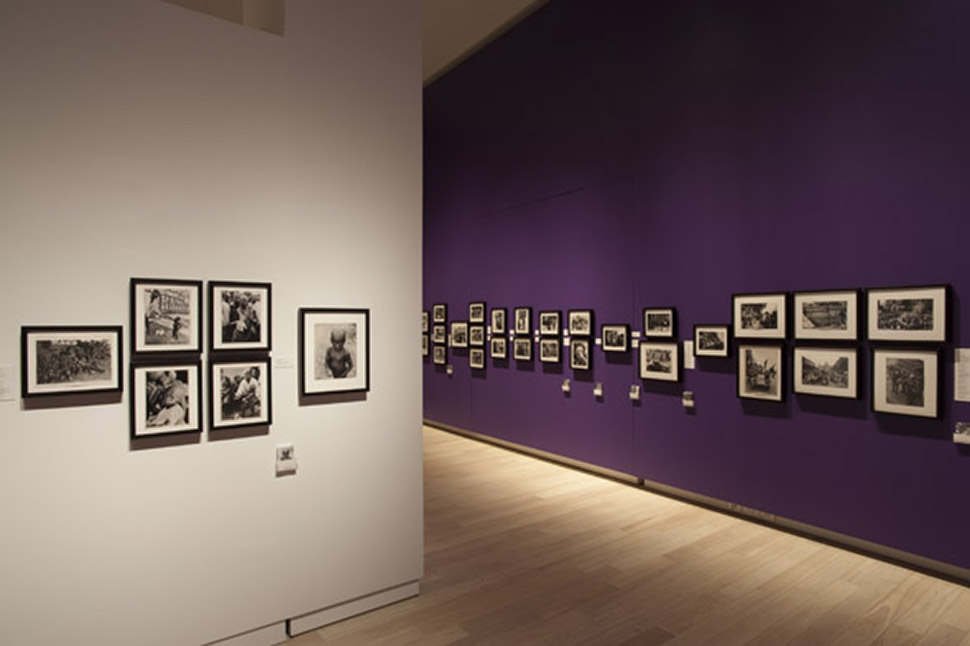Posted on June 4, 2013
In my last blog entry I considered W.J.T. Mitchell’s question “what do pictures really want?”1 , by way of an engagement with war photographer Tim Hetherington’s “Sleeping Soldier” series. This week, I continue to explore the ideas provoked by Mitchell’s query via a different set of photojournalistic images. Exhibited recently at Ryerson Image Centre, the show “Human Rights Human Wrongs” includes over 300 original prints from the Black Star Collection. Depicting human resistance in the face of social and political violence, the images respond to the broad theme of struggles for human rights and self-determination. I want to focus on one particular aspect of the exhibit – the miniature reproductions available for collection from small shelves interspersed throughout the exhibition space. Already the focus of discussion here at TPW R&D in Gabby Moser’s No Looking After the Internet monthly looking group and in Alison Cooley’s response to those meetings, I extend these conversations by considering the images in light of Mitchell’s inquiry.
Freely available to exhibition goers (I collected over 50 of them), the hand-held reproductions of images from the exhibit reflect significant historical and social events over five decades beginning with the civil rights movement in 1935. Many of the images depict direct violence (for example, the execution of a Vietcong terrorist in 1966), while others point to the systemic factors that produce it (members of the Klu Klux Klan ca. 1968). On the reverse of each miniature one finds pictorial details (where and when the photograph was taken and by whom) as well as a seemingly random list of world events that occurred during the same year. For instance, the text accompanying a June 26, 1980 photograph documenting a militarized operation at the University of San Salvador, catalogs the following series of occurrences:
El Salvador Archbishop Oscar Romero is assassinated (March 24) • Zimbabwe Independence (April 18); election of Prime Minister Robert Mugabe (April 18) • Iran-Iraq Beginning of the Iran-Iraq war (September 22) • Senegal President Senghor resigns (31 December), Abdou Diouf elected President • Peru End of the military regime, election of a right-wing civil government • El Salvador The civilian Jose Napoleon Duarte is elected President of El Salvador by an overwhelming majority, the first civilian President since 1931 • United States of America The U.S. Supreme Court orders the federal government to pay some $120 million dollars to eight tribes of the Sioux Indians in reparation for Native American land seized illegally by the government in 1877; the U.S. signs the Convention on the Elimination of All Forms of Discrimination Against Women.
There are two issues that interest me with regard to these take-away reproductions: first, is the physical action of collection as a supplement to looking; and second, is the juxtaposition of image and text as a method of visual encounter. Gabby Moser offers some reflections about what happens when images in the exhibit are reproduced as physical objects that viewers can “do” something with. Her curiosity is with how the invitation to collect is negotiated as a dynamic of what it means to encounter “difficult photographs.”2 I understand this difficulty as describing how conflict as represented in the world outside – through the visual image – returns the viewer to the affective and emotional conflicts of being human in a violent world. On the one hand, there is the desire to know and so for proximity. When touched upon, this same knowledge can overwhelm, and so the need for distance. In this context “difficult” is understood as a dynamic of social encounter rather than a quality belonging to the image itself.
An example of these dynamics might be reflected in how, according to Moser, visitors to the “Human Rights Human Wrongs” exhibit interact with the take-away photographs – some, for example, choose to collect the cards (randomly or systematically), while others do not. For those who accept the invitation, how do the images travel once they leave the gallery space? Do they sit on ones bookshelf for later contemplation; are they re-purposed as art objects (as one friend of mine did) or perhaps merely discarded? So frequently did those who gathered postcards subsequently request to return them, Moser notes, that the gallery set up a “Card Return” box. Here, the impulse to collect turns just as easily into the need to discard (but to do so thoughtfully). While we cannot know the intent of the viewer there is a sticky quality to the miniatures that make them hard to ignore.

The counterpoint between proximity and distance that characterizes an encounter with “difficult photographs” is evident too in the curatorial juxtaposition of image and text. The choice to augment pictorial details with a list of world events seems to me emblematic, assimilating the specificity of violence (done to particular bodies) into the wider discourse of human rights. What does the list “do”, I wonder, to ones encounter with the image? Does it offer a kind of geographical mapping of human violence, bringing one close to events that may seem remote? Remote to whom? Is the list rather meant to invite free association? Or, is it a historical mini-lesson? In each of these instances, I would argue, the text has a distancing effect, mitigating ones encounter with the image and what it might want.
Here I turn once again to Mitchell, whose unanswerable question of what the image wants alerts us to the violence of our own desire to know the image in a way that refuses its’ radical uncertainty. This uncertainty arises from allowing oneself to be affected by the surprise of the image and the force that might bring. For instance, how do the images of racialized conflict exhibited in “Human Rights Human Wrongs” call forth ones own archive of racialized experience? How is one differently situated in relation to these histories? Furthermore, what methods of looking might support the working through of these questions? It is this very dilemma that Moser wishes to explore with her No Looking After the Internet series. In these monthly looking groups, participants gather to discuss a series of photographic images stripped of their traditional gallery framing. By removing the typical contextual frameworks on which viewers rely (such as captions, curatorial statements and/or artist talks), “my goal”, writes Moser, “has been to push participants to try to make meaning from the images without relying on this information as an “answer” to what we are supposed to do with these difficult photographs, and our (affective) responses to them.”3 Removing these framing devices may shatter the illusion of curatorial authority but I’m curious what happens to the viewer thus unmoored.
Cooley reflects on this question in the context of the No Looking group discussions, where she notes the inclination of participants to ask the artist or curator for details about the work. “The aim”, Cooley suggests, “often appears to be to figure out the answer, to get to the bottom of the image’s meaning, to reveal information others may have accidentally overlooked.”4 There is a way in which the urge for authorial and curatorial details acts as a defense against encountering the image and how it frames the experience of looking. Indeed, it is this very dynamic that Moser’s No Looking After the Internet wishes to unseat. While Moser registers concern, in her role as the curator of the looking group, about the perceived “power dynamic” of her access to greater contextual knowledge than participants, such knowledge, I would suggest, gives her no greater understanding.5 If the method of the looking group is not about authority but rather how one encounters oneself via the process of collective looking, then perhaps the question of power is better framed as one of desire. Where the curator (or the artist for that matter) might know something about the image, Mitchell would suggest that there is more that we do not and cannot ever know. The image is more precisely the cause that instigates the desire to go on asking. The problem then becomes one of how to pose interesting questions and to do this together ethically. Cooley reflects on this undertaking as the ability to “balance a sensitivity to the image and its context (known or unknown), and a sensitivity to the group, with a desire to emphasize one’s own discovery.”6 With regard to the take-away miniatures from the “Human Rights Human Wrongs” exhibit, the question might then be: in the face of such overwhelming evidence of the human capacity for violence, what do we need to go on asking, of ourselves and of each other?
1. W.J.T. Mitchell. What Do Pictures “Really” Want? October, 77. (Summer, 1996), 71-82 ↩
2. Gabby Moser, “Thinking About No Looking”, April 12, 2013 http://archive.gallerytpw.ca/rd/thinking-about-no-looking/ ↩
3. Moser ibid.↩
4. Alison Cooley, “Not Knowing and No Looking”, May 15, 2013 http://archive.gallerytpw.ca/rd/not-knowing-and-no-looking/ ↩
5. Moser ibid.↩
6. Cooley ibid.↩










